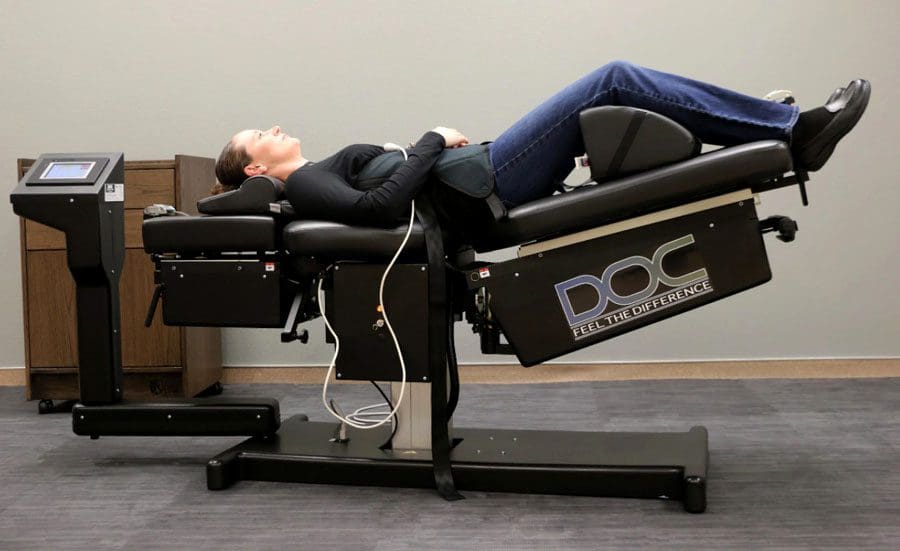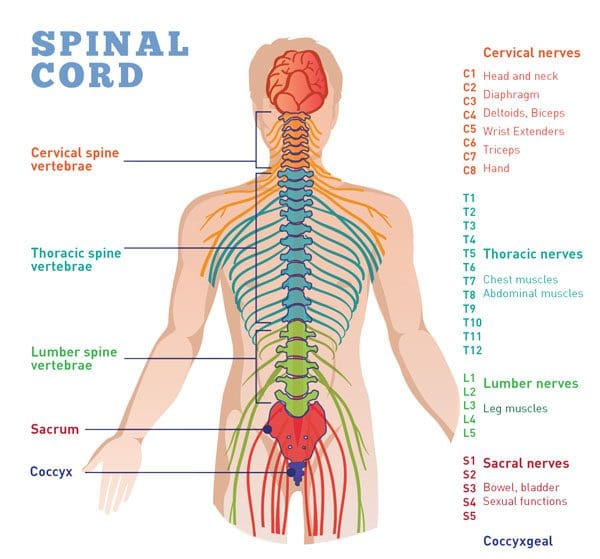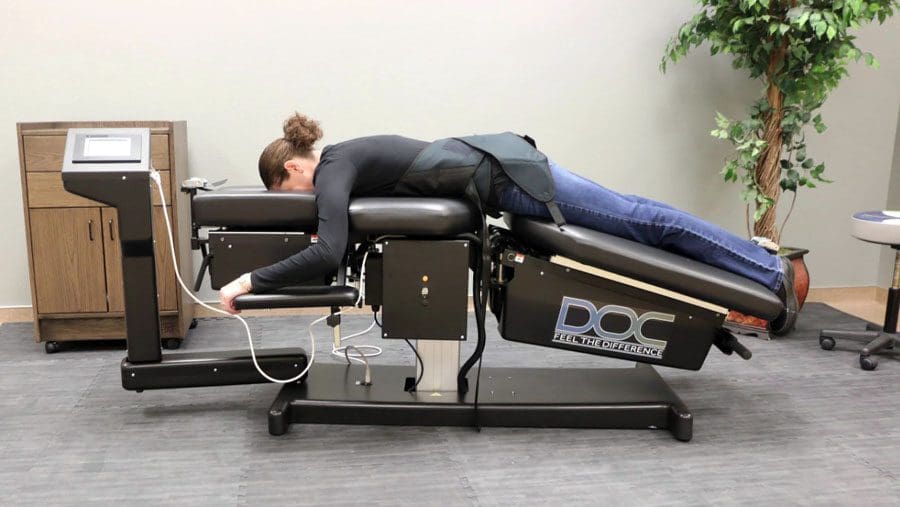Spinal Decompression
Spinal Decompression Treatment involves stretching out the spinal column using a motorized traction or decompression table that pulls compressed vertebrae back to their normal position to relieve back and/or leg pain. This procedure is nonsurgical decompression therapy, not the same as surgical spinal decompression, such as laminectomy and microdiscectomy. Both treatments relieve pain and promote optimal healing for bulging, degenerating, or herniated discs.

A Session Consists Of
- The individual’s doctor, spine specialist, or chiropractor will determine the treatment plan after their in-person physical evaluation and review of imaging scans like X-rays and/or MRI.
- Every case is different, but a session typically requires 20-30 minutes.
- Treatment plans differ in the number of sessions per week and the number of weeks necessary.
- Patients remain clothed during a spinal decompression therapy session and lie on a motorized table.
- Depending on the condition or injury, the patient could be in the prone position lying face down or lying supine face up.
- A harness is placed around the hips or neck.
- The technician/therapist sets up the program.
- The table will move slowly back and forth and/or to the sides to provide spinal traction, release the compression, and promote relaxation.
- There is no pain during or after the decompression therapy, but the patient will feel their spine stretch.
- To avoid any discomfort, the system has emergency stop switches for the patient and the therapist technician.
- The switches terminate the treatment immediately if the patient experiences pain or discomfort.

Physiological Well Being
- Increases blood circulation and promotes nutrient supply through the spine.
- Allows for proper disc rehydration.
- Prevents herniations from advancing or worsening.
Physical Well Being
- Lowers stress levels.
- Pain alleviation.
- Improves spinal mobility.
- Improves joint flexibility.
- Resume normal daily activities.
- Prevents muscle guarding.
- Helps to develop core strength.
- Helps to prevent new injuries.
Chiropractic Principle
Decompression therapy uses the same principle of spinal adjustments offered by chiropractors, physiotherapists, and osteopaths. Spinal decompression helps to promote retraction or repositioning of herniated or bulging disc material and lowers disc pressure to engage the body’s natural healing process.
- The machine/table gently stretches the spine, which changes the force and position of the spine.
- This takes the pressure off the spinal discs by creating negative pressure in the disc, taking pressure off nerves and other structures.
- This helps the circulation of water, oxygen, and nutrient-rich fluids into the discs to heal optimally.
Nonsurgical spinal decompression helps to treat:
- Neck pain
- Back pain
- Sciatica
- Bulging discs
- Herniated discs
- Degenerative disc disease
- Posterior facet syndrome, also known as worn spinal joints
- Injured spinal nerve roots
- Diseased spinal nerve roots

The Spine
The spine makes sure that the body is not falling apart as it is the body’s central support structure. Research studies have shown that as part of the musculoskeletal system since the spine is connected to different parts of the muscle tissues that make sure that the body is moving. The spine’s primary function is to help the body sit, stand, walk, twist, and bend as it is in motion. A healthy spine will have these natural curves that will absorb shocks that the body encounters and protect the spine itself from injury in an S-shaped curve. Other research studies have shown that the spine comprises bone, cartilage, ligaments, nerves, and muscles that play an integral role in how the spine is formed and how it functions. The many different parts that make up the spine include:
- Vertebrae
- Facet joints
- Intervertebral disks
- Spinal cord & nerves
- Soft tissues
When back pain or spinal injury starts to affect the back and the spine, many back issues will begin to affect the spinal health over time. This is due to the spine’s vertebrae and disks wearing down due to age, and that can cause the individual pain. There are ways to lessen the pain from the spine, and that is through spinal decompression therapy.
Decompression Table
- The spinal decompression table may consist of a manually operated cable and pulley system or a computerized table segmented by the upper and lower body.
- The angle and pressure depend on the type of injury and the individual’s needs.
- Each procedure is carefully calculated to reposition the spinal discs and disc material to alleviate pain.
Spinal decompression is a mechanized version of a chiropractic adjustment. By gently stretching and moving the spine, the vertebrae have proper alignment restored, restoring range of motion, decreasing or eliminating pain, and improving mobility and function.

- The individual is strapped to the machine with a harness that helps position the back for optimal decompression.
- Depending on the condition and severity, the therapist will choose from a list of decompression programs.
- Slowly, the spine is stretched and lengthened, relieving pressure.
- The spine’s stretching and repositioning are different from standard physical therapy and manual manipulation treatment.
- It is a gradual process to prevent the body from muscle guarding as the natural response to avoid injury.
Benefits
The spine takes a considerable toll from all the physical activity or lack of activity, leading to spinal compression, drying out and wearing down the spinal discs, and degeneration.
- Decompressing the spine decreases the susceptibility to this degeneration and breakdown.
- It is a non-invasive treatment that does not require medication/s.
- Provides natural pain relief by reducing pressure on the spine.
- Does not take long.
- Offers immediate results, with many patients experiencing pain relief after the first session.
- Back pain is eliminated by dealing with the source or root cause.
- Non-surgical spinal decompression therapy has been shown to:
- Reduce or eliminate pain.
- Rehydrate spinal discs.
- Reduce disc bulging/herniation.
- Improve functional abilities.
- Decrease the need for surgery.
Individuals Not Recommended To Undergo Decompression
Ask a doctor, spine specialist, or chiropractor whether or not the criteria are met for nonsurgical spinal decompression. Individuals with any of these conditions should not undergo decompression treatment. These include:
- Spinal fracture/s
- Spinal tumor/s
- Spinal implants
- Advanced osteoporosis
- Abdominal aortic aneurysm
DOC Decompression Table Features and Benefits
15 Must-Knows
References
American Spinal Decompression Association: “Spinal Decompression Therapy.”
Daniel DM. Nonsurgical spinal decompression therapy: Does the scientific literature support efficacy claims made in the advertising media? Chiropractic & Osteopathy 15:7, May 18, 2007.
Ramos G, Martin W. Effects of vertebral axial decompression on intradiscal pressure. Journal of Neurosurgery 81:350-353, 1994.
Wang G. Powered traction devices for intervertebral decompression: Health technology assessment update. Washington Department of Labor and Industries, June 14, 2004.


